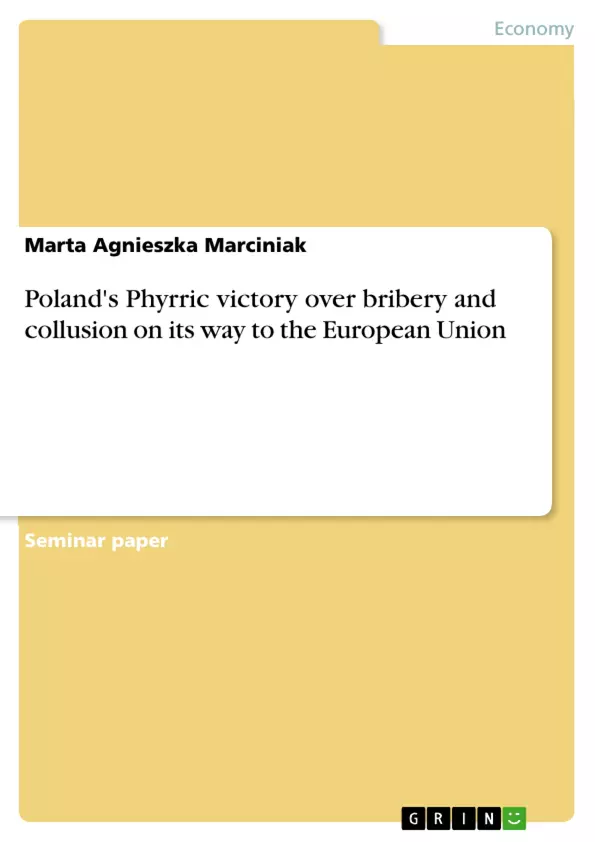Despite the bad impression Poland’s position in the Transparency International
Corruption Perceptions Index has remained unchanged since 1999.
Nevertheless, corruption is not declining but rather growing in several areas. As
a matter of fact, the number of scandals reporting “irregularities” involving
politicians and other public officials has been on the rise for the last two or three
years. So is the discussion of legislation and other measures. Attention shall be
drawn to the fact that the considerably higher number of convictions for
corruption since 1998, as well as the more common presence of corruptionrelated
topics in the media is rather due to greater media activity than thanks to
the effectiveness of institutions of prosecution.
According to several surveys corruption is most widespread in the healthcare
system, judiciary, sub-national governments and central State administration.
Furthermore, it is common in privatisation and off-budget agencies activities,
political party finance, as well as in the tax and customs administration.
Corruption becomes an important issue even in the private sector.
This paper aims to elaborate the impact of the EU accession on the anticorruption
policy. After presenting data and main areas of corruption, the most
important institutions and legislation will be dealt with. It seems that public
procurement is the area the most compatible with EU anti-corruption legislation.
Consequently, this topic will be discussed in detail in this paper. As already
mentioned, corruption in other areas is rather increasing as decreasing. The
reasons and consequences for this development will not be dealt with explicitly
in this paper, for, apparently, the EU accession process has not yet put enough
pressure on authorities to take measures against these widespread practices.
Inhaltsverzeichnis (Table of Contents)
- I. Introduction
- II. Figures and general aspects
- II. 1. The Data
- II. 2. Perceptions
- II. 3. Main fields of corruption
- III. Measures taken by the government
- III. 1. Anti-corruption policy
- III. 2. Corruption being a political issue
- III. 3. Impact of the EU accession
- IV. Institutions and legislation
- IV. 1. Anti-corruption legislation
- IV. 2. Audit and control
- The Supreme Audit Chamber (NIK)
- Internal audit
- IV. 3. Anti-corruption agencies
- IV. 4. Ombudsman
- V. Public Procurement
- V. 1. Legislative framework
- V. 2. Review and audit
- V. 3. Corruption
- VI. Conclusion
Zielsetzung und Themenschwerpunkte (Objectives and Key Themes)
This paper examines the impact of the European Union accession on Poland's anti-corruption policy. After presenting data and outlining the main areas of corruption, it delves into the significant institutions and legislation in place. The paper focuses particularly on public procurement, as it is the area most compatible with EU anti-corruption legislation. It explores the reasons why corruption in other areas is increasing rather than decreasing and discusses the consequences of this development.
- Impact of EU accession on Polish anti-corruption policy
- Prevalence and areas of corruption in Poland
- Key anti-corruption institutions and legislation
- Public procurement in relation to EU anti-corruption regulations
- Consequences of the increasing trend of corruption in specific sectors
Zusammenfassung der Kapitel (Chapter Summaries)
The introduction highlights Poland's unchanged position in the Transparency International Corruption Perceptions Index since 1999, despite the increasing number of corruption scandals involving politicians and public officials. It also mentions the rise in convictions for corruption since 1998 and the increased media attention on corruption-related topics.
Chapter II provides an overview of data and general aspects of corruption in Poland. This includes the number of final convictions for corruption, international perceptions of corruption in Poland, and the main fields of corruption identified in public opinion surveys.
Chapter III focuses on the measures taken by the Polish government to combat corruption. It explores the anti-corruption policy, the political implications of corruption, and the influence of EU accession on the country's anti-corruption efforts.
Chapter IV examines the institutions and legislation established to address corruption in Poland. This includes the anti-corruption legislation, the role of the Supreme Audit Chamber (NIK) and internal audit, the functions of anti-corruption agencies, and the role of the Ombudsman.
Chapter V delves into the specific topic of public procurement, analyzing the legislative framework, review and audit procedures, and the extent of corruption within this area. It explores aspects such as conflicts of interest, blacklisting, and the impact of EU legislation.
Schlüsselwörter (Keywords)
This paper focuses on key terms such as corruption, EU accession, anti-corruption policy, institutions, legislation, public procurement, Transparency International Corruption Perceptions Index, bribery, convictions, surveys, perceptions, and the impact of EU legislation on Polish anti-corruption efforts.
- Quote paper
- MMag. CEMS MIM Marta Agnieszka Marciniak (Author), 2003, Poland's Phyrric victory over bribery and collusion on its way to the European Union, Munich, GRIN Verlag, https://www.grin.com/document/18807



